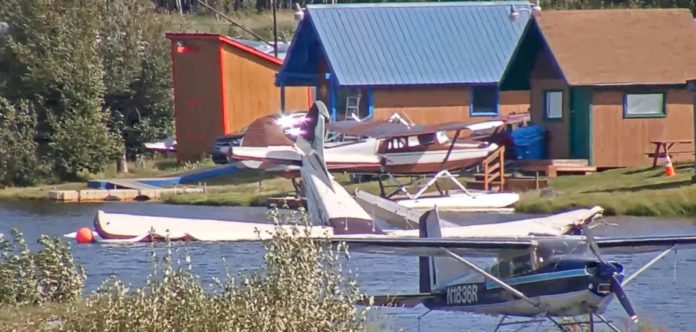Six people were onboard a floatplane that crashed on takeoff from Lake Hood about 9:18 am on Tuesday. Winds were brisk out of the Southwest on Tuesday, and windsocks around the lake were flapping when the plane apparently hit one of the fingers of the lake, where a jetty of land creates a division between channels of water.
According to National Transportation Safety Board, a pilot and six passengers on the de Havilland Canada DHC-2 Beaver were rescued and taken to a hospital. The plane, operated by Regal Air, was heading to Kati National Park, a popular bear-watching spot and the passengers on board were from out of state.
Two of the people onboard were seriously injured.

The pilot should never have taken off in that kind of weather. It would have been worth the wait, NO?
If pilots only flew on perfect blue sky sunny days with no wind, no one would be able to get anywhere in Alaska.
Pilots safely fly in all kinds of weather eaxh and every day. Unfortunately, flying is the same as driving, and accidents can and do happen.
But accidents most always are weather related. 40 accident free years learned me that. But you got your known and unknown conditions, and sometimes luck. Sometimes it is best to just call in sick.
That’s not too bad of weather. No it’s not flat calm but certainly flyable. The beaver should have been able to handle that much weight. Simply pilot error is all it is, no smoking mirrors here. I’m going to take a wild guess here and suggest that you’ve never flown into Perryville or Gamble on St Lawrence Island.
You really should check your spelling and grammar before you post your comments.
It’s over 250 miles each way to the bear viewing. Anyone thinking all weather conditions will be known in the course of a 500 plus mile route and a 12 hour day, would be mistaken. If you stay in bed all day, something will eventually come up there as well.
Yes weather conditions go down rapidly in Alaska but not usually during takeoff.
A most unfortunate accident for sure. From videos I have seen wind and weather though not ideal were certainly doable. With many hours in this make and model of airplane I would have done it a bit differently. This airplane is not tolerant of a nose high attitude and wants to climb at a fairly flat pitch attitude with wing flaps deployed. Dehavilland airplanes are known for that characteristic. It is easy to criticise from the comfort of your easy chair but the fact remains that I was not strapped in that airplane and have no way of knowing exactly what the pilot had to deal with. Very thankful that there were no fatalities and wishing the occupants a speedy recovery.
With a stall speed of 60 mph and a rate of climb at sea level of up to 1300 ft per minute, with lots of knock that down to let’s just say an even thousand feet per minute. He had a pretty moderate weight load on board with six passengers which isn’t that much. I’ve seen 207s with six people on board. They didn’t have any trouble. Beavers have been the lifeblood of Alaska and the bush in general for decades so the plane is definitely Worthy. If you take out mechanics and the weather, just about all you have left is pilot error which is the cause of most crashes.
Correct me if I’m wrong, but the video shows the plane half sunk in the taxi-way, not on a take-off area. Anyone know the particulars yet?
LeftSeater – We posted a video on Facebook of the crash. You can see it here: https://fb.watch/eyqBCvZ6aN/
No doubt, it was a Stall/spin accident.
Thanks, Suzanne. He was losing speed coming out of that first hard left turn. Sounds like he had power on full. But plane lost lift. May have been overweight. Maybe forgot to load fuel on both wings (yes, that sometimes happens). The Beaver gets lift quick with the big wings and radial engine. But floats are heavy and those tour flights get packed. Tragic!
One can pretty much discern from the video exactly when the pilot knew he was in trouble. He had climbed to only about 100 feet and had 4 seconds to react. Not enough altitude and certainly not enough time to assess and correct. Looks like it stalled under full power and dropped like a rock. It happens too fast.
I bet it will be determined an excessive aft CG.
Comments are closed.